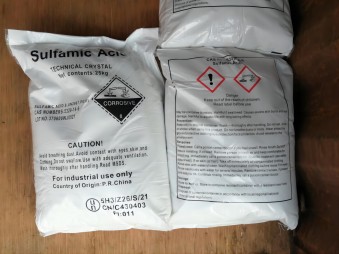Welcome to Linyi Kemele Co., Ltd
Sulfamic Acid

Sulfamic Acid
English alias: sulphamic acid; Amidosulfonic acid; Amidosulfuric acid; Aminosulfonic acid
CAS No.: 5329-14-6
EINECS:226-218-8
Molecular formula: NH2SO3H
Molecular weight: 97.094
Relative density (water=1): 2.126 g/cm³
Melting point: 205 ℃
UN NO.:2967
Appearance: Crystals or Crystalline Powder
Solubility (mg/L): Soluble in water and liquid ammonia, aqueous solution is highly ionized, strong acid. Slightly soluble in methanol, insoluble in ethanol and ether.
Uses: Sulfamic acid can be used in the synthesis of herbicides, fire retardants, sweeteners, preservatives, metal cleaners, etc. It is a common chemical raw material.
Storage precautions: sealed and dry storage. Tightly packed and stored in a dry and ventilated place. Storage and transportation with oxidizer and alkali. Pay attention to personal protection, do not direct physical contact. If ingested, gargle with water, drink milk or egg white.
Specific uses:
Galvanizing Bath
Sulfamic acid is commonly used when gold-plated or alloy, and the plating solution of gold-plated, silver, gold-silver alloy contains sulfamic acid 60 ~ 170 g per liter of water. The typical electroplating solution of silver-plated women's clothing needle is 125 g sulfamic acid per liter of water, which can obtain a very bright surface silver plating. Alkali metal sulfamate, ammonium sulfamate or sulfamate can be used as conductive and buffering compounds in the new aqueous gold plating solution.
When the nickel plating waste liquid is recovered, the resin is adsorbed by cation exchange resin and then cleaned with amino acid to desorption the adsorbed resin and regenerate the resin. For example, the treatment of 400 ppmNi electroplating waste liquid, with 150 g/L of amino acid 50 ml, recovered (NH2SO3)2112 g/L, NiSO4148 g/L. In the repair of nickel-plated parts, nickel plating is required, and 100 g/L sulfamic acid can be used in its anode treatment. Before nickel plating, the nickel plating surface should be cleaned with 0.003 ~ 0.1 grams of sulfamic acid solution.
The content of sulfamic acid in copper plating solution is 3 ~ 20 L, the role of sulfamic acid is to make the coating fine and ductile, and its viscosity is high.
During iridium plating, NH2SO3H/Ir≥7, the obtained iridium coating has no cracks, the iridium layer is 15 microns thick, and the adhesive force is large. The product has good activity in automatic anti-pollution equipment.
When rhodium-rhenium alloy is plated on silverware and electrical components, the sulfasulfonic acid in the conductivity is 100 g/L, and when the coating thickness is ≤5 microns, it has high hardness and strong corrosion resistance, and the coating is very bright and beautiful.
The rhodium - rhenium electroplating layer on brass has high hardness and corrosion resistance, the electroplating solution contains sulfonic acid 100 g/L, concentrated sulfuric acid 50 g/L, rhodium (such as sulfate)2 g/L, rhenium (such as K3N(RuCl4H2O2)2) 0.05 g/L, at 65℃ and 1 ~ 2 A/decimeter 2 conditions, Deposition rate 3 ~ 4 mmol/min.
Italy has used lead sulfamate bath instead of fluorosilicic acid bath, which can reduce pollution. It has many uses in the anticorrosive aluminum industry. The product has good luster and excellent processing performance.
PIC: Emily Zhang
Email: km19@kmchem.com
WhatsApp/Mobile: +86 15563290155
Prev: Calcium Carbide